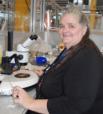Scholarship recipients focus on recycled fuels to improve sustainability of nuclear industry
Two early career nuclear scientists who received international scholarships have spent time in the Nuclear Fuel Cycle group at ANSTO are making progress on their work to improve nuclear fuel.









